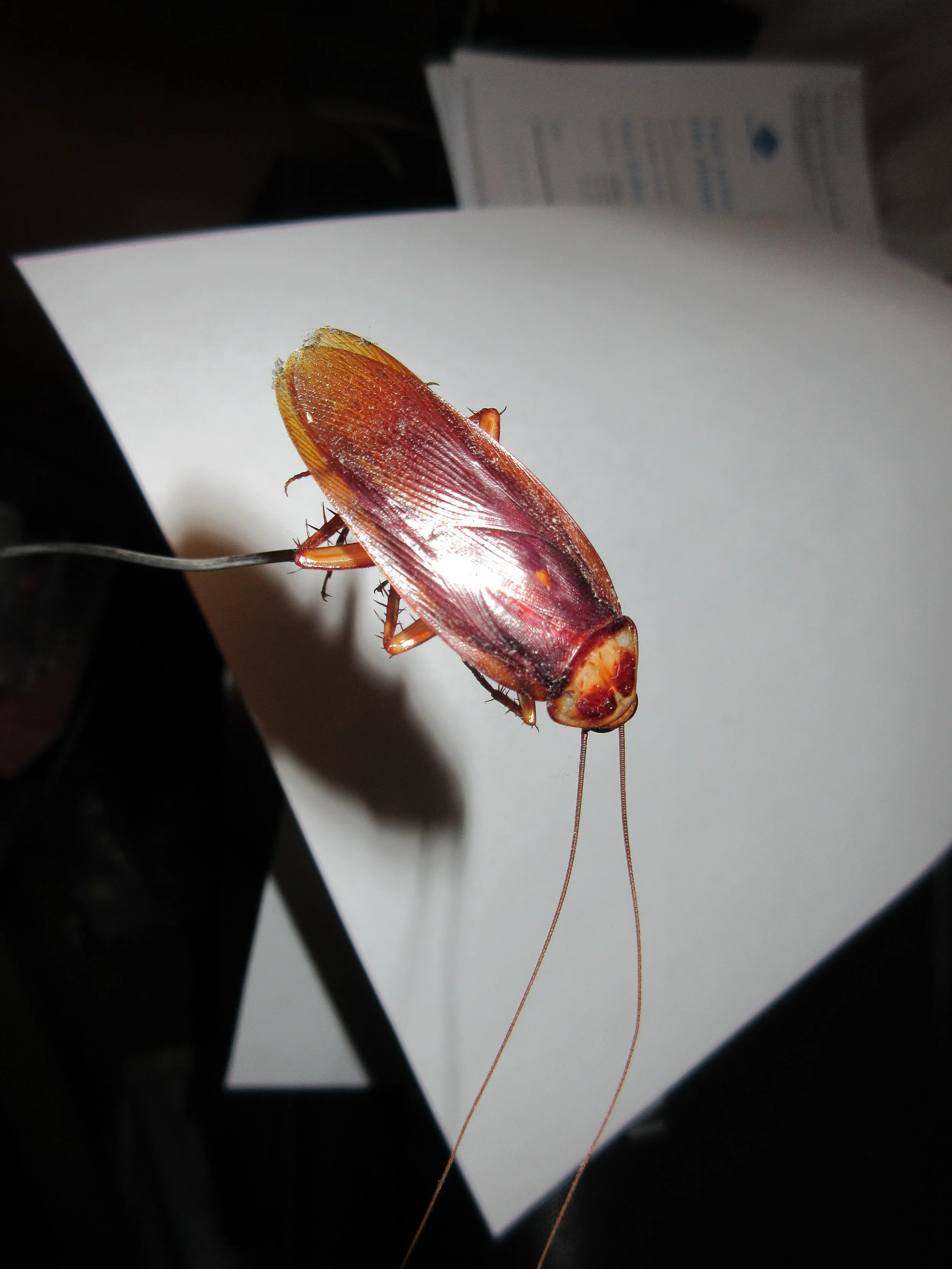Cockroach Control
Cockroach Control
The German Cockroach ( Blattella germanica)
The German cockroach is the most common and widespread household cockroach. Adults are ½ to 5/8 inch long and have light brown to tan bodies. There are two dark brown stripes on the pronotum, running from front to back. Both adults males and females have well-developed wings, but they do not fly. Cockroaches are most common in areas of the house in which there are abundant food and water, high humidity, and safe harborage. They are usually found in kitchens and bathrooms. However, they may invade other rooms if sanitation is poor or if the population gets very large. German cockroaches are active at night, searching for food and water. Small nymphs usually remain within harborages, foraging for food scrapes there. Newly hatched nymphs must also feed on cockroach feces. Seeing adults or nymphs during the day is a clue that the population is large.
While females are producing and carrying an egg case, they are inactive. They rarely feed or seek water and remain hidden. This behavior tends to protect them and their young from pest control efforts.
German cockroahes have small yellowish and brown egg cases. A German cockroach egg case contains from 30 to 40 eggs. The females carries the egg case on the tip of her abdomen until about 24 hours before the eggs are ready to hatch. Then, she drops the egg case and leave the nymphs to fend for themselves. An adult female lives for about six months. On average, she will produce one egg case a month, or about 150 to 240 nymphs in all. The average life cycle is about 100 days under favaorable conditions.
What Method Needed To Control German Cockroaches?
At H. L. Cooper Pest Control, for infestaions we apply a residual insecticide to crack & crevices, baseboards, under sinks, beneath and behind stoves & refrigerators, cabinets, around windows & doors frames and uitlites installations . In some cases, a dust and or bait is apply to harborage. Bait won’t work if residual insecticide is applied on it. This residual will last about 30 days. A flushing agent (fogging) is apply which kills on contact and penetrate harborage. The goal is to kill over 95% of the population during the initial cleanout. Since females producing and carrying egg cases are inactive and remain hidden, a follow-up treatments is need in 30 days. Many time it looks as if pest control effort did not work because nymphs are seen a few weeks after treatment. This is a normal part of the pest control process. The second and sometime a third treatment is needed to eliminate this problem. But, re-infestation can and will occur if new German cockroaches are being re-introduce back into treatment area. Apartment units can have this problem, but preventive treatment to units on either side of the troubled unit solves this problem.
American Cockroach (Periplaneta Americana)
The American cockroach is the largest species in Virginia. Adults maybe up to 2-1/8 inches long, and they typically range from 1-3/8 to 1-1/2 inches in length. Adult cockroaches are reddish brown. The pronotum has a light-colored margin without stripes. The last segment of the cercus is at least twice as long as it is wide. In this species, the male has wings longer than abdomen. The female's wings are shorter, just covering the abdomen. Males and females are weak to moderately good fliers.
American cockroaches prefer warm, moist habitats. In southern regions of the United States, this species both an indoor and outdoor pest. Indoors, it usually frequents kitchens, bathrooms, basements, boiler rooms, steam tunnels, warehouses, and sewer systems. Outdoors, it lives in leaf litter around the house, in flowerbeds, in rotting wood, firewood piles, alleyways, and dumps. In northern regions of the country, this species is primarily an indoor pest; however, some individuals will move outdoors during the warm months.
American cockroaches often infest warm basements areas, near water heaters, floor drains, and/or water sumps. They are usually found below ground or at ground level. From basements and sewer systems they move into living spaces, but usually not in large numbers. American cockroaches move by running from place to place. They cannot easily climb smooth surfaces, so they may become trapped in a sink or bathtub. Although they often infest homes, American cockroaches are much likely to infest commercial buildings such as restaurants, bakeries, grocery stores, food processing plants, and hospitals.
The female American cockroach usually drops and secures her egg case as soon as it is produced. The adult female may live for 12 to 15 months and usually lays nine to ten egg cases, each containing 14 to 16 eggs. The females often deposit their egg cases or glue them with mouth secretions in protected places. The cockroaches may cover egg cases with pieces of organic matter. The nymphs feed on the same food as the adults. Cockroaches will complete their development and become reproductive in six to 12 months. The adults and nymphs actively forage during the warm months of the year. Adults live about six to eight months.
Other Periplaneta cockroach species are also household pests. These include the smokybrown cockroach, P. brunnea. The biology and habits of these species are similar to that of the American cockroach. They are much more common farther south. However, they are found in parts of Virginia.


